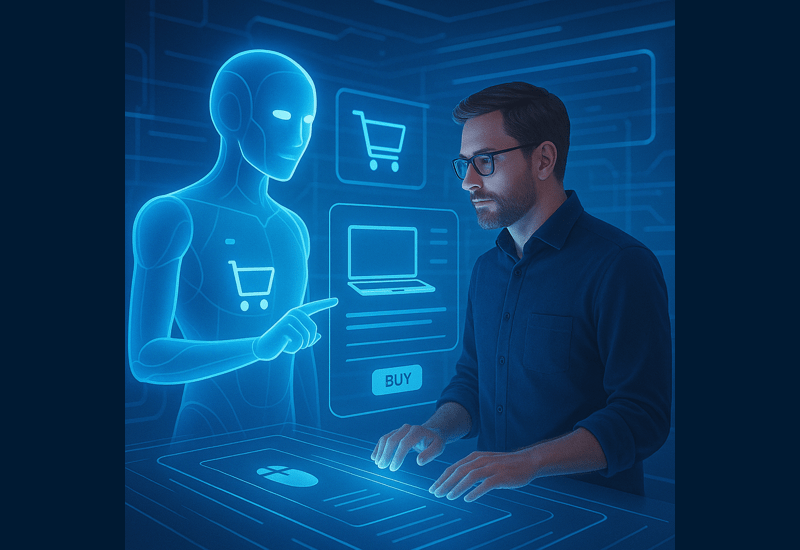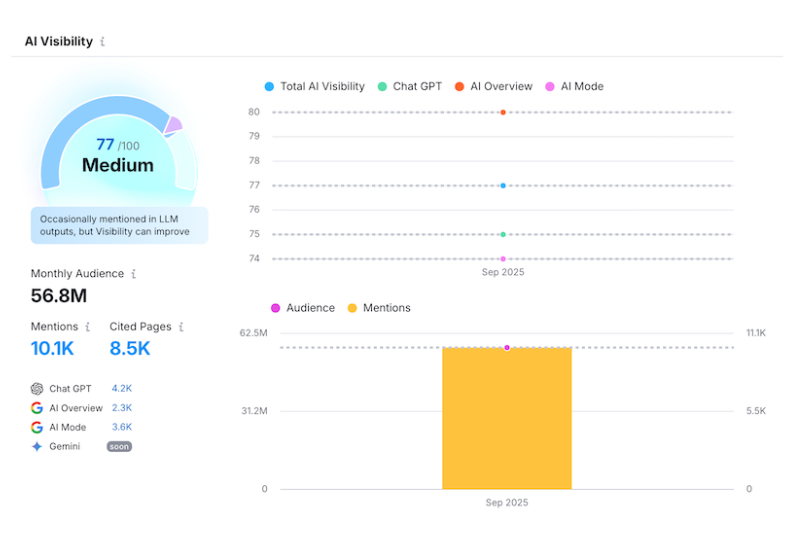The way buyers find, evaluate, and purchase products is fundamentally changing. And if you’re a manufacturer or distributor, that shift will impact your business sooner than you think.
Welcome to the era of Agentic Commerce: where AI agents represent buyers, handle procurement tasks autonomously, and increasingly bypass traditional websites entirely. These agents don’t browse, they act—executing everything from product discovery to checkout in milliseconds.
For distributors and manufacturers, this evolution is both a challenge and a massive opportunity. If your systems and product data aren’t accessible to these new interfaces, you’ll be invisible. But if you get on board soon, you’ll gain first-mover advantages in speed, automation, and discoverability across a new generation of intelligent buyer interfaces.
What is Agentic Commerce?
Agentic Commerce refers to the emerging model where autonomous AI agents—powered by LLMs (Large Language Models)—handle commercial transactions on behalf of human users. These agents:
- Understand buyer intent
- Search product catalogs in real time
- Negotiate and place orders
- Trigger logistics and payments, without a human clicking through a website
This is already happening. Tech alliances like the Agentic Commerce Alliance (ACA) are building shared schemas, return APIs, and secure checkout protocols. And payment providers like Visa and PayPal are rolling out agent-ready APIs.
If you rely on eCommerce channels, ERP integrations, or manual quoting systems—this is your cue to start preparing.
This shift isn’t hypothetical—it’s already underway, as seen in initiatives by Visa, PayPal, and Perplexity AI (Hamann, 2025).
Why Manufacturers and Distributors Need to Act Now
Most B2B companies still manage product data manually. Catalogs are fragmented across systems, pricing is buried in ERPs, and APIs are inconsistent or nonexistent. That creates friction for human buyers—and a wall for AI agents.
Forward-looking orgs are already working with partners like Human Element to:
- Centralize product and pricing data
- Expose structured APIs for agents to consume
- Adopt open schemas that make your offerings readable to machines
Think of this as the next evolution of eCommerce—one where visibility depends on your system’s ability to speak the same language as the buyer’s AI.
History Rhymes: Agentic Commerce and the EDI Parallel
For those of us who’ve been in B2B long enough, the current wave of Agentic Commerce feels strikingly familiar. In the late 1990’s, the industry grappled with a similar challenge: How do we get disparate systems to speak the same language?
Back then the solution was Electronic Data Interchange (EDI). It brought structure and standardization to digital transactions. Companies aligned on transaction codes, document types, and protocols like ANSI X12 and EDIFACT. It wasn’t fast, and it wasn’t always elegant, but it worked. EDI helped globalize supply chains, streamline procurement, and eventually became table stakes for large-scale B2B operations.
Agentic Commerce is following a similar trajectory—except it’s moving faster, and the stakes are even higher. Instead of document types, we’re aligning on open schemas and API protocols. Instead of on-prem EDI servers, we’re looking at real-time, AI-mediated negotiation and fulfillment. But the core challenge remains: interoperability.
Just like EDI didn’t eliminate sales relationships but enhanced transactional efficiency, Agentic Commerce won’t remove human decision-makers. It will remove friction, especially in the repeatable, structured parts of the buying journey.
For manufacturers and distributors, this is your EDI moment—but with LLMs and APIs instead of flat files and FTP. The companies that invested early in EDI became the supply chain backbones of their industries. The same will be true for those who invest now in agentic infrastructure.
The 7–10 Year Technology Roadmap for Agentic B2B Commerce
Phase 1: Foundation (0–2 years)
- Adopt open data standards (e.g., JSON-LD, GS1, or ACA’s commerce schema)
- Centralize product info, inventory, and pricing into a PIM/ERP-integrated system
- Build read/write APIs for core commerce functions (pricing, ordering, availability)
Phase 2: AI Enablement (2–5 years)
- Implement AI-enriched product tagging and taxonomy development
- Enable agent-ready workflows: real-time quoting, instant returns, automated PO processing
- Participate in a pilot program (e.g., through ACA or with Human Element) to test agent compatibility
Phase 3: Intelligent Commerce (5–10 years)
- Launch a zero-click commerce API for large buyers and procurement systems
- Offer machine-to-machine contract negotiation and volume discounts
- Integrate with agentic marketplaces and platform-native LLMs for real-time fulfillment
Three Key Features to Build Now
1. Structured, Interoperable Product Data
Agents don’t scrape websites—they query structured data. Your product catalog must be machine-readable, well-classified, and enriched with metadata. Start now with a strong PIM and aligned taxonomy strategy.
2. API-First Architecture
Enable your systems to support instant quoting, availability checks, and ordering through secure, scalable APIs. This is the new “website” for B2B buyers and their agents.
3. AI-Enriched Content and Context
AI agents rely on more than SKUs—they use context. Implement tools that generate variant-rich content, FAQs, and troubleshooting info, and expose it through accessible endpoints.
This also supports a higher “Uniqueness Index,” improving your product’s visibility among agent-driven queries (Hamann, 2025).
How Does Agentic Come Together Safely?
Security & Trust Frameworks
As AI agents begin transacting on behalf of human users, trust, authentication, and data security become foundational to agentic commerce. These agents must act with precision, within defined permissions, and in secure digital environments. Several well-established protocols and practices make this possible:
Trust and Authentication
OAuth 2.0 enables secure, delegated access—allowing AI agents to act on behalf of users without exposing login credentials. A buyer can authorize an agent to access their account, fetch pricing, or place orders within defined scopes and time limits.
Tokenization adds an extra layer of safety. Once access is granted, the agent receives a time-limited, revocable access token rather than full user credentials.
Digital Certificates and Mutual TLS (mTLS)
Digital certificates are used to verify the identity of both client (agent) and server (merchant system). This ensures that both parties in a transaction are legitimate and authorized.
Mutual TLS (mTLS) strengthens this trust by requiring both sides to present certificates—preventing man-in-the-middle attacks and unauthorized actors from spoofing a trusted party.
Data Security and Integrity
All agentic communications must be encrypted in transit (TLS) and protected at rest with strong encryption standards.
Real-time transactions depend on event-driven APIs and secure webhook callbacks to ensure agents work with current data, without stale or incorrect inventory, pricing, or availability.
Policy Controls and Governance
Enterprises define policy rules to govern what agents can do: max spend limits, vendor exclusions, volume thresholds, etc.
Systems log and audit every transaction, enabling full traceability and accountability—critical for both security and compliance.
These security building blocks are already in use across fintech, healthcare, and high-trust enterprise systems. By adopting them, Agentic Commerce can evolve safely—empowering agents to act decisively, but never recklessly.
How Human Element Can Help
At Human Element, we’ve built eCommerce architecture for some of the most complex B2B environments in North America. We understand the technical debt most manufacturers and distributors carry—and we’re helping clients leap ahead through:
- Composable commerce architecture audits
- Agent-readiness assessments
- Structured product data migration
- API enablement and AI integration
Whether you’re exploring Shopware, BigCommerce, Adobe Commerce, or a custom stack, we can help you bridge the gap between traditional eCommerce and agentic commerce.
These services align with strategic implementation steps laid out in Shopware’s Agentic Commerce roadmap (Hamann, 2025).
The Future of B2B Belongs to Those Who Prepare for It
Agentic Commerce isn’t a trend—it’s the next evolution of how transactions happen. And while it won’t replace every B2B relationship overnight, those who prepare their systems and data for it today will capture the attention of tomorrow’s buyers—human and machine alike.
Start the transition now. Get in touch with Human Element to begin your Agentic Commerce readiness journey.
Sources: – https://agentic-commerce.sh/
– Hamann, Stefan. ‘Agentic Commerce Cheat Sheet.‘ Shopware, May 2025.
– Hamann, Stefan. ‘Agentic Commerce Whitepaper.’ Shopware, 2025.



